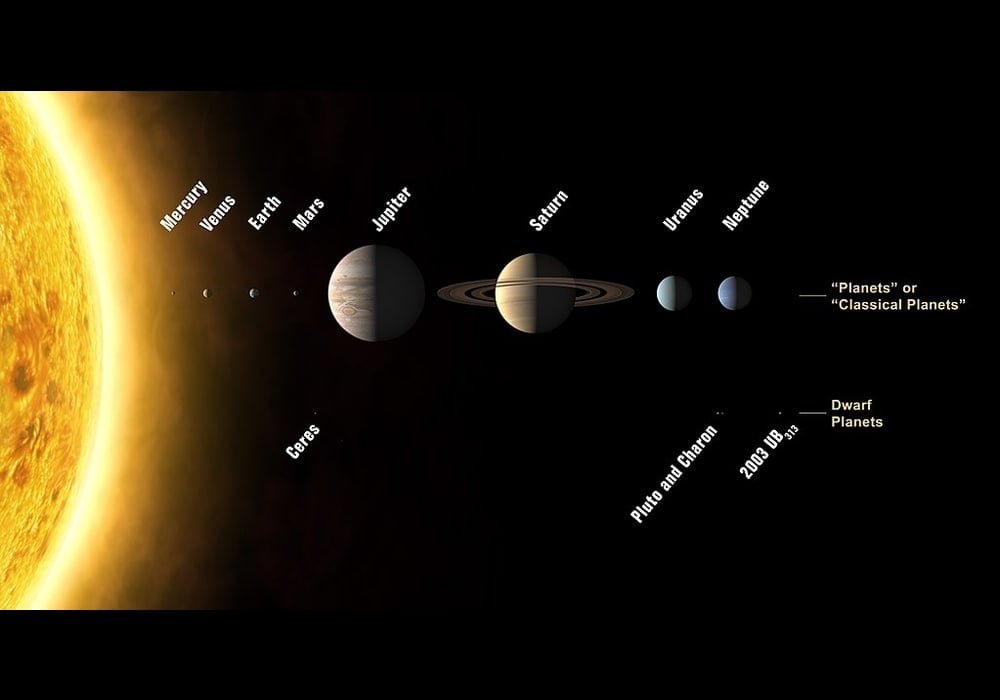Solar system: what is it?
We call the Solar System, all the stars subject to the Sun’s gravitational field (our star alone represents 99.8% of the total mass of the Solar System!). The Solar System evolves in one of the arms of our spiral galaxy, the Milky Way, some 26,000 light years from its center. According to the definitions established by the International Astronomical Union, our Solar System includes in particular:
- Eight planets – and their natural satellites; there are more than 175 known – which are Mercury, Venus, Earth, Mars, Jupiter, Saturn, Uranus and Neptune, in order of distance from the Sun. The first four are qualified as terrestrial planets, the last four as gas planets.
- Dwarf planets like Pluto or Ceres.
- Several hundred thousand asteroids composed mainly of rocks and metallic minerals. Their size is extremely variable, from several hundred kilometers to specks of dust. They are grouped mainly in the main Asteroid Belt, located between Mars and Jupiter.
- Thousands of comets made up of dust and volatile ice.
- Countless small icy bodies like the Centaurs – which orbit between Jupiter and Neptune – or even the transneptunian objects in the distant Kuiper Belt.
Solar system: a world full of surprises
Beyond the Kuiper Belt would be a gigantic set of icy bodies known as the Oort Cloud. Its outer limit would mark the limit of the Sun’s gravitational influence. Astronomers estimate it to be somewhere between 1.6 and 2 light years – or between 101,186 and 126,482 astronomical units – from our star! But the heliosphere – that bubble created by solar winds – does not extend that far. The interstellar medium interrupts it in a direction a hundred astronomical units away, or only some 0.002 light-years away.
Read also: The order of the planets closest to the sun
For astronomers It still have surprises. Certain regions such as the area between the Sun and Mercury are still poorly understood. The orbits of several transneptunian objects suggest that a ninth planet, perhaps 4 times the size of Earth and 10 times more massive, could be lurking at the edge of our Solar System, between 500 and 1,200 astronomical units from the Sun.
Composition
The Sun contains 99.85% of all matter in the solar system. The planets, which are formed from the same disc of material that forms the Sun, contain only 0.135% of the mass of the solar system. Jupiter contains more than twice the matter of all the other planets together. The satellites of the planets, comets, asteroids, meteorites and the interplanetary medium constitute the remaining 0.015%.
The following table is a list of the mass distribution within the solar system:
- Sun: 99.85%
- Planets: 0.135%
- Counts: 0.01%?
- Satellites: 0.00005%
- Minor Planets: 0.0000002%?
- Meteoroids: 0.0000001%?
- Interplanetary Medium: 0.0000001%?
How old is our solar system?
Our solar system is approximately 4.6 billion years old. This age is determined based on the radiometric dating of meteorite samples, which provide insights into the formation of the earliest solids in the solar system.
Different kinds of meteorites: chondrites, siderites, pallasites…
Formation and evolution of the solar system
The formation and evolution of the Solar System is determined by a model that is widely accepted today and known as the “Solar Nebula Hypothesis”. This model was first developed in the 18th century by Emanuel Swedenborg, Emmanuel Kant and Pierre-Simon de Laplace. The developments resulting from this hypothesis have involved a wide variety of scientific disciplines including astronomy, physics, geology and planetology. Since the start of the conquest of space in the 1950s and following the discovery of exoplanets in the 1990s, the models have been questioned and refined to take into account new observations.
According to estimates from this model, the Solar System began to exist 4.55 to 4.56 billion years ago with the gravitational collapse of a small part of a giant molecular cloud. Most of the mass of the initial cloud collapsed in the center of this area, forming the Sun, while its scattered remnants formed the protoplanetary disk on the basis of which the planets, moons, asteroids and the other small bodies of the Solar System.
The Solar System has evolved considerably since its initial formation. Many moons and planets have formed from gaseous discs and dust surrounding the sun, while others are believed to have been formed independently and then captured by a planet. Finally, still others, like the Moon of the Earth, would be (very probably) the result of cataclysmic collisions. Collisions between bodies have taken place continuously to the present day and have played a central role in the evolution of the Solar System. The positions of the planets have slipped noticeably, and some planets have swapped places. It is now assumed that this planetary migration was the main driver of the evolution of the young Solar System.
In about 5 billion years, the Sun will cool and expand well beyond its current diameter, to become a red giant. It will then eject its upper layers according to the planetary nebulae scheme, and will leave behind a stellar corpse: a white dwarf. In the distant future, the gravitational attraction of stars passing in the vicinity will then gradually tear the procession of planets of the old system from its star. Some planets will be destroyed while others will be ejected into space. After several trillions of years, it is likely that the Sun, turned into a black dwarf, will be alone and icy, without any body orbiting in its orbit.
Sources: PinterPandai, NASA, Britannica
Photo credit: Wikimedia Commons
Earth Core Cooling | This is what will happen when the Earth’s core is cold?



